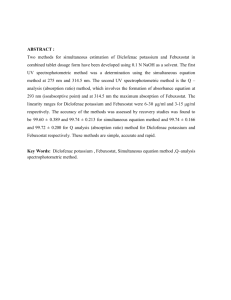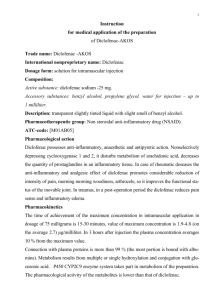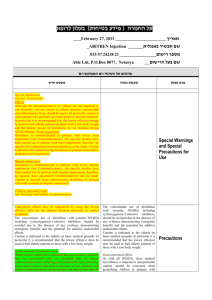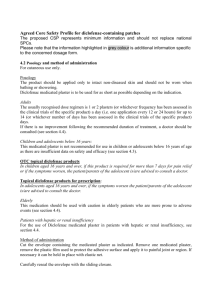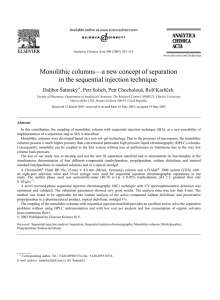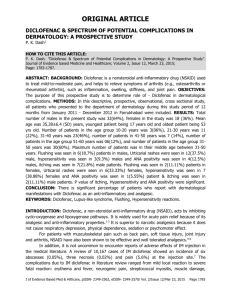Proposed Core Safety Profile for diclofenac – systemic formulations
advertisement
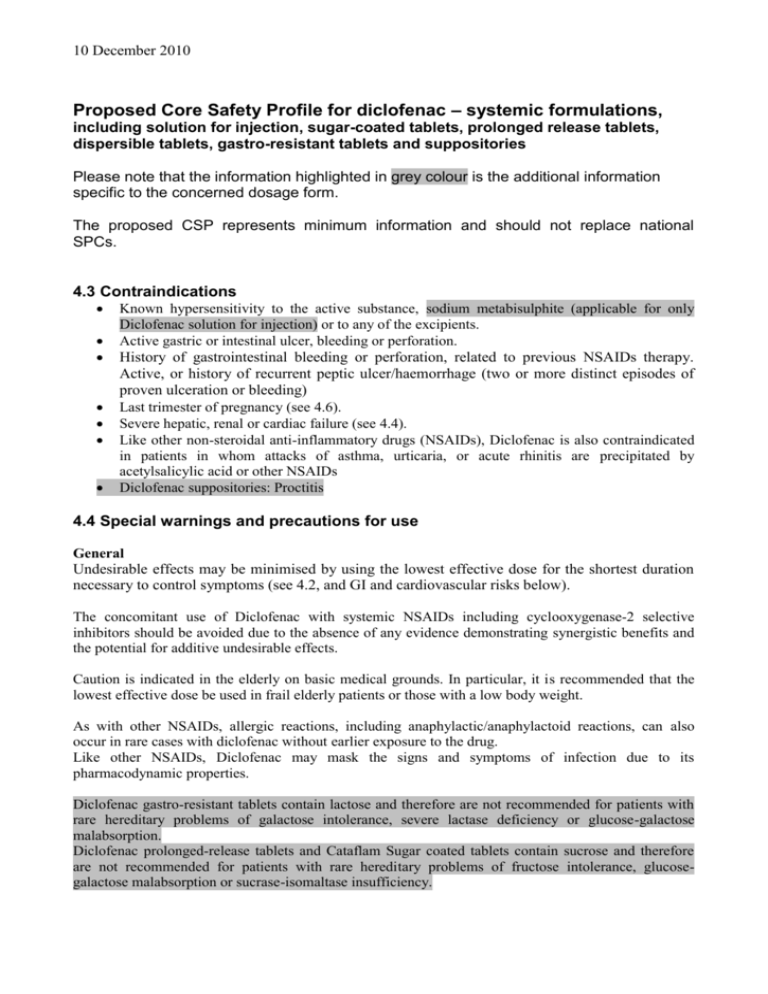
10 December 2010 Proposed Core Safety Profile for diclofenac – systemic formulations, including solution for injection, sugar-coated tablets, prolonged release tablets, dispersible tablets, gastro-resistant tablets and suppositories Please note that the information highlighted in grey colour is the additional information specific to the concerned dosage form. The proposed CSP represents minimum information and should not replace national SPCs. 4.3 Contraindications Known hypersensitivity to the active substance, sodium metabisulphite (applicable for only Diclofenac solution for injection) or to any of the excipients. Active gastric or intestinal ulcer, bleeding or perforation. History of gastrointestinal bleeding or perforation, related to previous NSAIDs therapy. Active, or history of recurrent peptic ulcer/haemorrhage (two or more distinct episodes of proven ulceration or bleeding) Last trimester of pregnancy (see 4.6). Severe hepatic, renal or cardiac failure (see 4.4). Like other non-steroidal anti-inflammatory drugs (NSAIDs), Diclofenac is also contraindicated in patients in whom attacks of asthma, urticaria, or acute rhinitis are precipitated by acetylsalicylic acid or other NSAIDs Diclofenac suppositories: Proctitis 4.4 Special warnings and precautions for use General Undesirable effects may be minimised by using the lowest effective dose for the shortest duration necessary to control symptoms (see 4.2, and GI and cardiovascular risks below). The concomitant use of Diclofenac with systemic NSAIDs including cyclooxygenase-2 selective inhibitors should be avoided due to the absence of any evidence demonstrating synergistic benefits and the potential for additive undesirable effects. Caution is indicated in the elderly on basic medical grounds. In particular, it is recommended that the lowest effective dose be used in frail elderly patients or those with a low body weight. As with other NSAIDs, allergic reactions, including anaphylactic/anaphylactoid reactions, can also occur in rare cases with diclofenac without earlier exposure to the drug. Like other NSAIDs, Diclofenac may mask the signs and symptoms of infection due to its pharmacodynamic properties. Diclofenac gastro-resistant tablets contain lactose and therefore are not recommended for patients with rare hereditary problems of galactose intolerance, severe lactase deficiency or glucose-galactose malabsorption. Diclofenac prolonged-release tablets and Cataflam Sugar coated tablets contain sucrose and therefore are not recommended for patients with rare hereditary problems of fructose intolerance, glucosegalactose malabsorption or sucrase-isomaltase insufficiency. 10 December 2010 Voltfast powder for oral solution contains a source of phenylalanine and may be therefore harmful for patients with phenylketonuria. Diclofenac Dolo soft capsules contain sorbitol and therefore are not recommended for patients with rare hereditary problems of fructose intolerance The sodium metabisulphite present in solution for injection can also lead to isolated severe hypersensitivity reactions and bronchospasm. For OTC products only: Low-dose, short-term, oral diclofenac forms with headache indication: Prolonged use of any type of painkiller for headaches can make them worse. If this situation is experienced or suspected, medical advice should be obtained and treatment should be discontinued. The diagnosis of MOH should be suspected in patients who have frequent or daily headaches despite (or because of) the regular use of headache medications. Diclofenac solution for injection must not be given to premature babies or neonates. Benzylalcohol may cause toxic reactions and anaphylactoid reactions in infants and children up to 3 years of age. This concerns IV formulations only. Gastrointestinal effects Gastrointestinal bleeding, ulceration or perforation, which can be fatal, has been reported with all NSAIDs, including diclofenac, and may occur at any time during treatment, with or without warning symptoms or a previous history of serious gastrointestinal events. They generally have more serious consequences in the elderly. If gastrointestinal bleeding or ulceration occurs in patients receiving Diclofenac, the medicinal product should be withdrawn. As with all NSAIDs, including diclofenac, close medical surveillance is imperative and particular caution should be exercised when prescribing Diclofenac in patients with symptoms indicative of gastrointestinal (GI) disorders or with a history suggestive of gastric or intestinal ulceration, bleeding or perforation (see 4.8). The risk of GI bleeding is higher with increasing NSAID doses and in patients with a history of ulcer, particularly if complicated with haemorrhage or perforation . The elderly have an increased frequency of adverse reactions to NSAIDs especially gastrointestinal bleeding and perforation which may be fatal. To reduce the risk of GI toxicity in patients with a history of ulcer, particularly if complicated with haemorrhage or perforation, and in the elderly, the treatment should be initiated and maintained at the lowest effective dose. Combination therapy with protective agents (e.g. proton pump inhibitors or misoprostol) should be considered for these patients, and also for patients requiring concomitant use of medicinal products containing low-dose acetylsalicylic acid (ASA)/aspirin or other medicinal products likely to increase gastrointestinal risk. Patients with a history of GI toxicity, particularly the elderly, should report any unusual abdominal symptoms (especially GI bleeding). Caution is recommended in patients receiving concomitant medications which could increase the risk of ulceration or bleeding, such as systemic corticosteroids, anticoagulants, anti-platelet agents or selective serotonin-reuptake inhibitors (see 4.5). 10 December 2010 Close medical surveillance and caution should also be exercised in patients with ulcerative colitis or Crohn’s disease, as their condition may be exacerbated (see 4.8). Hepatic effects Close medical surveillance is required when prescribing Diclofenac to patients with impaired hepatic function, as their condition may be exacerbated. As with other NSAIDs, including diclofenac, values of one or more liver enzymes may increase. During prolonged treatment with Diclofenac, regular monitoring of hepatic function is indicated as a precautionary measure. If abnormal liver function tests persist or worsen, if clinical signs or symptoms consistent with liver disease develop, or if other manifestations occur (e.g. eosinophilia, rash), Diclofenac should be discontinued. Hepatitis may occur with use of diclofenac without prodromal symptoms. Caution is called for when using Diclofenac in patients with hepatic porphyria, since it may trigger an attack. Renal effects As fluid retention and oedema have been reported in association with NSAID therapy, including diclofenac, particular caution is called for in patients with impaired cardiac or renal function, history of hypertension, the elderly, patients receiving concomitant treatment with diuretics or medicinal products that can significantly impact renal function, and in those patients with substantial extracellular volume depletion from any cause, e.g. before or after major surgery (see 4.3). Monitoring of renal function is recommended as a precautionary measure when using Diclofenac in such cases. Discontinuation of therapy is usually followed by recovery to the pre-treatment state. Skin effects Serious skin reactions, some of them fatal, including exfoliative dermatitis, Stevens-Johnson syndrome, and toxic epidermal necrolysis, have been reported very rarely in association with the use of NSAIDSs (see 4.8). Patients appear to be at highest risk for these reactions early in the course of therapy: the onset of the reaction occurring in the majority of cases within the first month of treatment. <Invented name> should be discontinued at the first appearance of skin rash, mucosal lesions, or any other sign of hypersensitivity. Cardiovascular and cerebrovascular effects For OTC products only: Caution (discussion with doctor or pharmacist) is required prior to starting treatment in patients with a history of hypertension and/or heart failure as fluid retention, hypertension and oedema have been reported in association with NSAID therapy. Clinical trial and epidemiological data suggest that use of diclofenac, particularly at high doses (150mg daily) and in long-term treatment may be associated with a small increased risk of arterial thrombotic events (for example myocardial infarction or stroke). Available data do not suggest an increased risk with use of low dose diclofenac <dose range of OTC product> up to <refer to recommended duration for use of OTC product>. For POM products only: Appropriate monitoring and advice are required for patients with a history of hypertension and/or mild to moderate congestive heart failure as fluid retention and oedema have been reported in association with NSAID therapy. 10 December 2010 Clinical trial and epidemiological data suggest that use of diclofenac (particularly at high doses, 150mg daily and in long term treatment) may be associated with a small increased risk of arterial thrombotic events (for example myocardial infarction or stroke). Patients with uncontrolled hypertension, congestive heart failure, established ischaemic heart disease, peripheral arterial disease, and/or cerebrovascular disease should only be treated with < substance> after careful consideration. Similar consideration should be made before initiating longer-term treatment of patients with risk factors for cardiovascular disease (e.g. hypertension, hyperlipidaemia, diabetes mellitus, and smoking). Haematological effects Use of Diclofenac D/Voltfast/Cataflam sugar coated tablets is recommended only for short term treatment. During prolonged treatment with Diclofenac, as with other NSAIDs, monitoring of the blood count is recommended. Like other NSAIDs, Diclofenac may temporarily inhibit platelet aggregation. Patients with defects of haemostasis should be carefully monitored Pre-existing asthma In patients with asthma, seasonal allergic rhinitis, swelling of the nasal mucosa (i.e. nasal polyps), chronic obstructive pulmonary diseases or chronic infections of the respiratory tract (especially if linked to allergic rhinitis-like symptoms), reactions on NSAIDs like asthma exacerbations (so-called intolerance to analgesics / analgesics-asthma), Quincke’s oedema or urticaria are more frequent than in other patients. Therefore, special precaution is recommended in such patients (readiness for emergency). This is applicable as well for patients who are allergic to other substances, e.g. with skin reactions, pruritus or urticaria. Diclofenac solution for injection: Special caution is recommended when Diclofenac is used parenterally in patients with bronchial asthma because symptoms may be exacerbated. 4.5 Interaction with other medicinal products and other forms of interaction The following interactions include those observed with Diclofenac gastro-resistant tablets and/or other pharmaceutical forms of diclofenac. Lithium: If used concomitantly, diclofenac may raise plasma concentrations of lithium. Monitoring of the serum lithium level is recommended. Digoxin: If used concomitantly, diclofenac may raise plasma concentrations of digoxin. Monitoring of the serum digoxin level is recommended. Diuretics and antihypertensive agents: Like other NSAIDs, concomitant use of diclofenac with diuretics or antihypertensive agents (e.g. beta-blockers, angiotensin converting enzyme (ACE) inhibitors) may cause a decrease in their antihypertensive effect. Therefore, the combination should be administered with caution and patients, especially the elderly, should have their blood pressure periodically monitored. Patients should be adequately hydrated and consideration should be given to monitoring of renal function after initiation of concomitant therapy and periodically thereafter, particularly for diuretics and ACE inhibitors due to the increased risk of nephrotoxicity. Concomitant treatment with potassium-sparing drugs may be associated with increased serum potassium levels, which should therefore be monitored frequently (see 4.4). 10 December 2010 Other NSAIDs and corticosteroids: Concomitant administration of diclofenac and other systemic NSAIDs or corticosteroids may increase the frequency of gastrointestinal undesirable effects (see 4.4). Anticoagulants and anti-platelet agents: Caution is recommended since concomitant administration could increase the risk of bleeding (see 4.4). Although clinical investigations do not appear to indicate that diclofenac affects the action of anticoagulants, there are isolated reports of an increased risk of haemorrhage in patients receiving diclofenac and anticoagulants concomitantly. Close monitoring of such patients is therefore recommended. Selective serotonin reuptake inhibitors (SSRIs): Concomitant administration of systemic NSAIDs, including diclofenac, and SSRIs may increase the risk of gastrointestinal bleeding (see 4.4). Antidiabetics: Clinical studies have shown that diclofenac can be given together with oral antidiabetic agents without influencing their clinical effect. However, there have been isolated reports of both hypoglycaemic and hyperglycaemic effects necessitating changes in the dosage of the antidiabetic agents during treatment with diclofenac. For this reason, monitoring of the blood glucose level is recommended as a precautionary measure during concomitant therapy. Methotrexate: Diclofenac can inhibit the tubular renal clearance of methotrexate hereby increasing methotrexate levels. Caution is recommended when NSAIDs, including diclofenac, are administered less than 24 hours before or after treatment with methotrexate, since blood concentrations of methotrexate may rise and the toxicity of this substance be increased. Ciclosporin: Diclofenac, like other NSAIDs, may increase the nephrotoxicity of ciclosporin due to the effect on renal prostaglandins. Therefore, it should be given at doses lower than those that would be used in patients not receiving ciclosporin. Quinolone antibacterials: There have been isolated reports of convulsions which may have been due to concomitant use of quinolones and NSAIDs. Phenytoin: When using phenytoin concomitantly with diclofenac, monitoring of phenytoin plasma concentrations is recommended due to an expected increase in exposure to phenytoin. Colestipol and cholestyramine: These agents can induce a delay or decrease in absorption of diclofenac. Therefore, it is recommended to administer diclofenac at least one hour before or 4 to 6 hours after administration of colestipol/ cholestyramine. Potent CYP2C9 inhibitors: “Caution is recommended when co-prescribing diclofenac with potent CYP2C9 inhibitors (such as sulfinpyrazone and voriconazole), which could result in a significant increase in peak plasma concentration and exposure to diclofenac due to inhibition of diclofenac metabolism. Diclofenac resinate/Flotac hard gelatin capsules (diclofenac resinate): Due to the fact that resinate is a basic ion exchanger; generally an inhibition of absorption of other orally given medicinal products has to be taken into account. 4.6 Pregnancy and lactation Pregnancy 10 December 2010 Inhibition of prostaglandin synthesis may adversely affect the pregnancy and/or the embryo/foetal development. Data from epidemiological studies suggest an increased risk of miscarriage and of cardiac malformation and gastroschisis after use of a prostaglandin synthesis inhibitor in early pregnancy. The absolute risk for cardiovascular malformation was increased from less than 1%, up to approximately 1.5 %. The risk is believed to increase with dose and duration of therapy. In animals, administration of a prostaglandin synthesis inhibitor has been shown to result in increased pre- and post-implantation loss and embryo-foetal lethality. In addition, increased incidences of various malformations, including cardiovascular, have been reported in animals given a prostaglandin synthesis inhibitor during the organogenetic period. During the first and second trimester of pregnancy, <INN> should not be given unless clearly necessary. If <INN> is used by a woman attempting to conceive, or during the first and second trimester of pregnancy, the dose should be kept as low and duration of treatment as short as possible. During the third trimester of pregnancy, all prostaglandin synthesis inhibitors may expose the foetus to: - cardiopulmonary toxicity (with premature closure of the ductus arteriosus and pulmonary hypertension); - renal dysfunction, which may progress to renal failure with oligo-hydroamniosis; the mother and the neonate, at the end of pregnancy, to: - possible prolongation of bleeding time, an anti-aggregating effect which may occur even at very low doses. - inhibition of uterine contractions resulting in delayed or prolonged labour. Consequently, <INN> is contraindicated during the third trimester of pregnancy. Lactation Like other NSAIDs, diclofenac passes into the breast milk in small amounts. Therefore, Diclofenac should not be administered during breast feeding in order to avoid undesirable effects in the infant. Fertility As with other NSAIDs, the use of Diclofenac may impair female fertility and is not recommended in women attempting to conceive. In women who have difficulties conceiving or who are undergoing investigation of infertility, withdrawal of Diclofenac should be considered. 4.7 Effects on ability to drive and use machines Patients experiencing visual disturbances, dizziness, vertigo, somnolence or other central nervous system disturbances while taking Diclofenac, should refrain from driving or using machines. 4.8 Undesirable effects Adverse reactions (Table 1) are ranked under heading of frequency, the most frequent first, using the following convention: very common: (>1/10); common (≥1/100, <1/10); uncommon (≥1/1,000, <1/100); rare (≥1/10,000, <1/1,000); very rare (<1/10,000); Not known: cannot be estimated from the available data. The following undesirable effects include those reported with either short-term or long-term use. Table 1 Blood and lymphatic system disorders Very rare Immune system disorders Rare Thrombocytopenia, leukopenia, anaemia (including haemolytic and aplastic anaemia), Agranulocytosis. Hypersensitivity, anaphylactic and anaphylactoid 10 December 2010 Very rare Psychiatric disorders Very rare Nervous system disorders Common Rare Very rare Eye disorders Very rare Ear and labyrinth disorders Common Very rare Cardiac disorders Very rare Vascular disorders Very rare Respiratory, thoracic and mediastinal disorders Rare Very rare Gastrointestinal disorders Common Rare Very rare Hepatobiliary disorders Common Rare Very rare Skin and subcutaneous tissue disorders Common Rare Very rare Renal and urinary disorders Very rare General disorders and administration site conditions Common Rare reactions (including hypotension and shock). Angioneurotic oedema (including face oedema). Disorientation, depression, insomnia, nightmare, irritability, psychotic disorder. Headache, dizziness. Somnolence. Paraesthesia, memory impairment, convulsion, anxiety, tremor, aseptic meningitis, taste disturbances, cerebrovascular accident. Visual disturbance, vision blurred, diplopia. Vertigo. Tinnitus, hearing impaired. Palpitations, chest pain, cardiac failure, myocardial infarction. Hypertension, vasculitis. Asthma (including dyspnoea). Pneumonitis. Nausea, vomiting, diarrhoea, dyspepsia, abdominal pain, flatulence, anorexia. Gastritis, gastrointestinal haemorrhage, haematemesis, diarrhoea haemorrhagic, melaena, gastrointestinal ulcer (with or without bleeding or perforation). Colitis (including haemorrhagic colitis and exacerbation of ulcerative colitis or Crohn's disease), constipation, Stomatitis (including ulcerative stomatitis), glossitis, oesophageal disorder, diaphragm-like intestinal strictures, pancreatitis. Transaminases increased. Hepatitis, jaundice, liver disorder. Fulminant hepatitis, hepatic necrosis, hepatic failure. Rash. Urticaria. Bullous eruptions, eczema, erythema, erythema multiforme, Stevens-Johnson syndrome, toxic epidermal necrolysis (Lyell's syndrome), dermatitis exfoliative, loss of hair, photosensitivity reaction, purpura , allergic purpura, pruritus. Acute renal failure, haematuria, proteinuria, nephrotic syndrome, interstitial nephritis, renal papillary necrosis. Injection site reaction, injection site pain, injection site induration (Applicable only for Diclofenac solution for injection) Application site irritation. (Applicable only for Diclofenac suppositories) Oedema Injection site necrosis. (Applicable only for Diclofenac 10 December 2010 solution for injection) Infections and infestations Very rare Injection site abscess. (Applicable only for Diclofenac solution for injection) Clinical trial and epidemiological data suggest that use of diclofenac, particularly at high doses (150 mg daily) and in long term treatment may be associated with a small increased risk of arterial thrombotic events (for example myocardial infarction or stroke) (see 4.4). 4.9 Overdose Symptoms There is no typical clinical picture resulting from diclofenac over dosage. Over dosage can cause symptoms such as vomiting, gastrointestinal haemorrhage, diarrhoea, dizziness, tinnitus or convulsions. In the event of significant poisoning, acute renal failure and liver damage are possible. Therapeutic measures Management of acute poisoning with NSAIDs, including diclofenac, essentially consists of supportive measures and symptomatic treatment. Supportive measures and symptomatic treatment should be given for complications such as hypotension, renal failure, convulsions, gastrointestinal disorder, and respiratory depression. Special measures such as forced diuresis, dialysis or haemo-perfusion are probably of no help in eliminating NSAIDs, including diclofenac, due to the high protein binding and extensive metabolism. Activated charcoal may be considered after ingestion of a potentially toxic overdose, and gastric decontamination (e.g. vomiting, gastric lavage) after ingestion of a potentially life threatening overdose (This information is not applicable for Diclofenac suppositories and Diclofenac solution for injection).
